GRAVITATION DIAGRAM BASED QUESTIONS
1.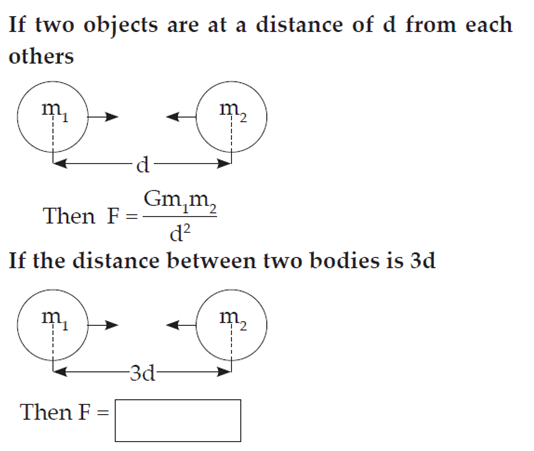
2.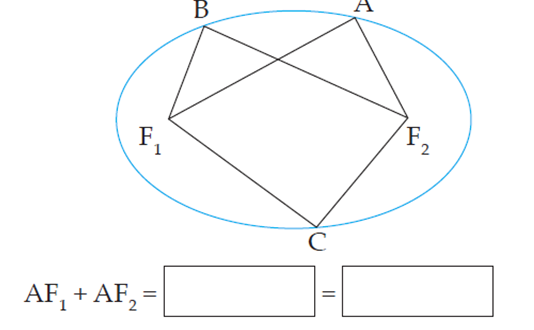
GRAVITATION DIAGRAM BASED QUESTIONS
3.
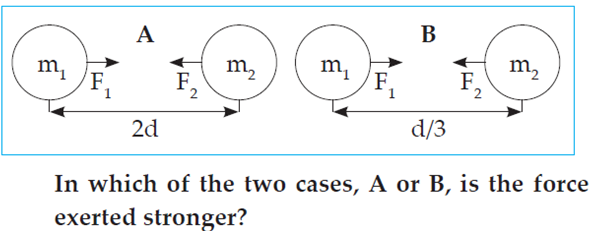
GRAVITATION DIAGRAM BASED QUESTIONS
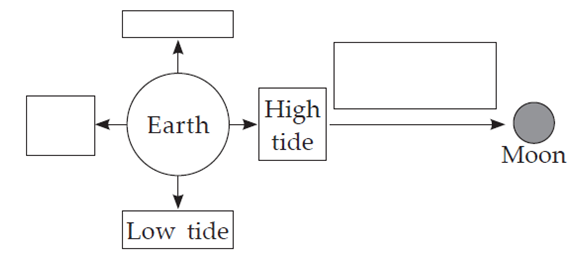
4.Complete the flow chart:
GRAVITATION DIAGRAM BASED QUESTIONS
5.Which of the following best represent force between the Sun and the Earth.

6.Observe the figure and answer the following questions.
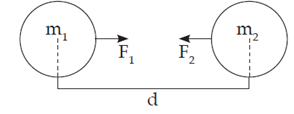
GRAVITATION DIAGRAM BASED QUESTIONS
1.Which law do we understand from the above diagram? State the law.
From the above diagram, we understand Newton’s law of gravitation.
Every object in the universe attracts every other object with a definite force.
This force is directly proportional to the product of the masses of the two objects and inversely proportional to the square of the distance between them.
2.State the mathematical equation for the law.
F = Gm1 m2
__________________
d2
3.In case the two bodies are not spherical, then in which direction is the force directed?
If the two bodies are not spherical, then the direction of force is along the line joining their centres of mass.
4.How will the value of force F change if the mass m2 is increased to 4 m2?
If the mass m2 is increased to 4m2, then the force will be –
F’ = Gm1 (4m2)
____________________
d2
F’ =4 Gm1 m2
____________________
d2
F’ = 4F
Force becomes 4 times the initial force.
5.How will the value of force F change if the distance is doubled?
If the distance between the two bodies is doubled, the force will be –
F’ = Gm1 m2
(2d)2
F’ = Gm1 m2
4d2
F’ = ¼ F
The force becomes one forth the initial force.
GRAVITATION DIAGRAM BASED QUESTIONS
7.The force of Gravitation between two bodies having irregular shape is taken to be the distance between their
(a) centre of mass
(b) centre of the body
(c) Edge of the body
Centre of mass
8.If the distance between the two bodies is tripled, how will the Gravitational force between them change?
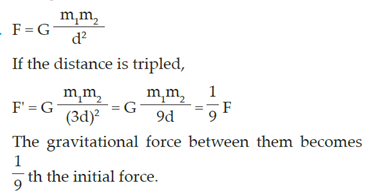
9.The mass of m2 was reduced to 50% and the force exerted by m1 on m2 was found to be 20 N, what will be the force exerted by m2 on m1?
The force exerted by m2 on m1 is 20 N.
GRAVITATION DIAGRAM BASED QUESTIONS
10.Why gravitational constant is called universal constant?
The value of gravitational constant does not depend upon the nature and size of the bodies. It also does not depend upon the nature of the medium between two bodies; hence it is called universal constant.
11.What will happen to gravitational force if mass of one of the objects is doubled?
If the mass of one of the objects is doubled, then the gravitational force between them also gets doubled.
GRAVITATION DIAGRAM BASED QUESTIONS
12.What is the value of universal constant in SI?
In SI system, the value of ‘G’ is 6.67 × 10–11 Nm2/kg2.
13.Identify the mistake in the given diagram and draw it again.
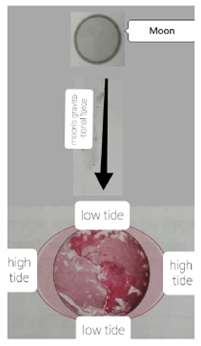
GRAVITATION DIAGRAM BASED QUESTIONS
14.Observe the given figure and answer these questions
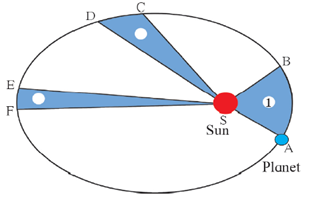
A. What is the conclusion about the orbit of a planet.
The orbit of the planet is an ellipse with the sun at one of the foci.
B.What is the relation between velocity of planet and distance from sun?
The closer the planet to the sun, the faster will be its velocity.
3.ASB, CSD and ESF relation between areas explain.
Area ASB, CSD and ESF are equal when the planet covers distances AB, CD and EF in same time.
GRAVITATION DIAGRAM BASED QUESTIONS
15.Observe the given figure showing the orbit of a planet moving around the sun and write the three laws related to it.
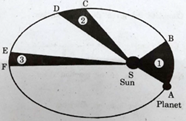
First law – The orbit of a planet is an ellipse with the Sun at one of the foci.
Second law – The line joining the planet and the Sun sweeps (Covers) equal areas in equal intervals of time.
Third law – The square of period of revolution of the planet around the Sun is directly proportional to the cube of the mean distance of a planet from the Sun.
GRAVITATION DIAGRAM BASED QUESTIONS
16.The figure shows the elliptical orbit of a planet about the Sun S. An ellipse is the curve obtained when a cone is cut by an inclined plane. It has two focal points. The sum of the distances to the two focal points from every point on the curve is constant. F1 and F2 are the two focal points of the ellipse. The shaded area CF1D is twice the shaded area AF1B. t1 is the time taken by the planet to move from C to D and t2 is the time to move from A to B.
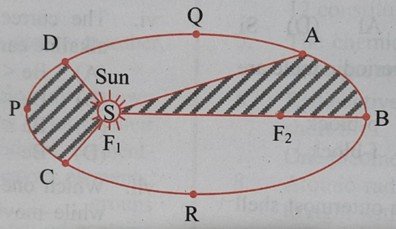
- Which laws do we understand from the above diagram and description?
- State the law regarding areas swept by the line joining the planet and the Sun.
- State the law regarding the time period of revolution of a planet.
- Out of the following points P, Q, R, B; at which point will the velocity of the planet be maximum?
- Express relation between t1, and t2
GRAVITATION DIAGRAM BASED QUESTIONS
https://akshatakirpekar.com/animal-classification/
https://youtu.be/zV0gwjYePlI?si=2jIp9Gnfv2nJ2PRD
GRAVITATION DIAGRAM BASED QUESTIONS